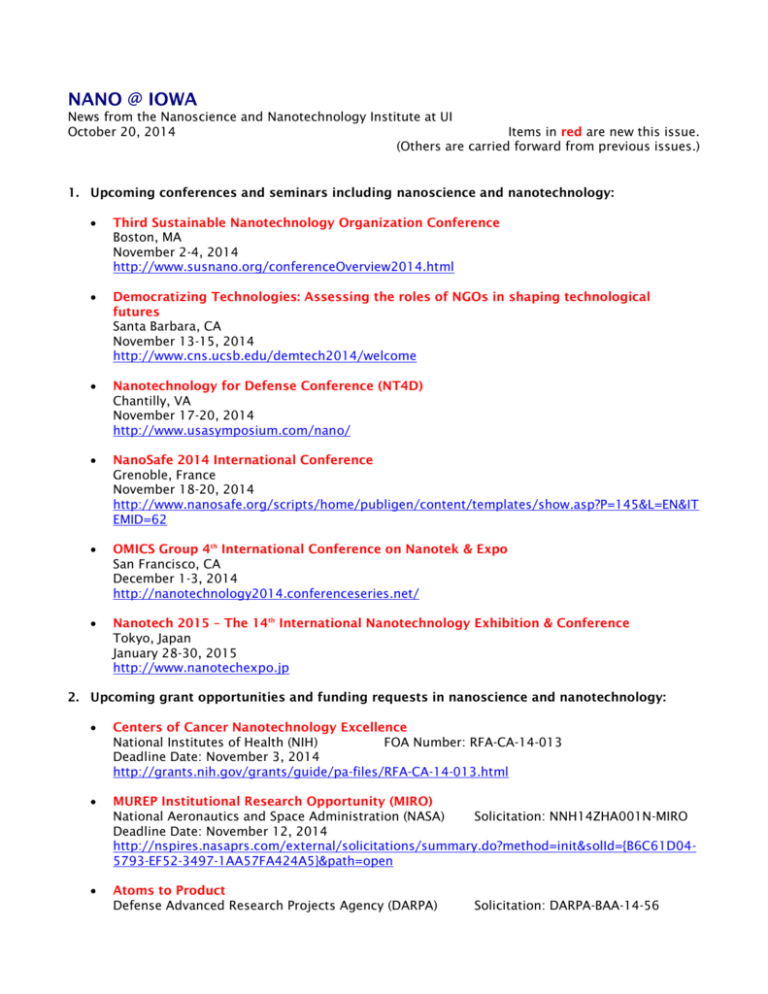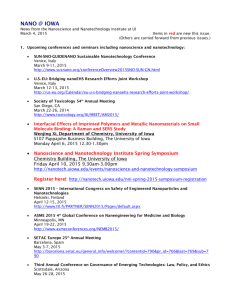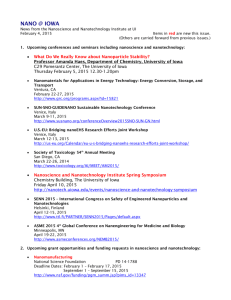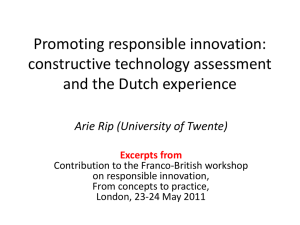nano @ iowa weekly - Nanoscience and Nanotechnology Institute
advertisement

NANO @ IOWA
News from the Nanoscience and Nanotechnology Institute at UI
October 20, 2014
Items in red are new this issue.
(Others are carried forward from previous issues.)
1. Upcoming conferences and seminars including nanoscience and nanotechnology:
Third Sustainable Nanotechnology Organization Conference
Boston, MA
November 2-4, 2014
http://www.susnano.org/conferenceOverview2014.html
Democratizing Technologies: Assessing the roles of NGOs in shaping technological
futures
Santa Barbara, CA
November 13-15, 2014
http://www.cns.ucsb.edu/demtech2014/welcome
Nanotechnology for Defense Conference (NT4D)
Chantilly, VA
November 17-20, 2014
http://www.usasymposium.com/nano/
NanoSafe 2014 International Conference
Grenoble, France
November 18-20, 2014
http://www.nanosafe.org/scripts/home/publigen/content/templates/show.asp?P=145&L=EN&IT
EMID=62
OMICS Group 4th International Conference on Nanotek & Expo
San Francisco, CA
December 1-3, 2014
http://nanotechnology2014.conferenceseries.net/
Nanotech 2015 – The 14th International Nanotechnology Exhibition & Conference
Tokyo, Japan
January 28-30, 2015
http://www.nanotechexpo.jp
2. Upcoming grant opportunities and funding requests in nanoscience and nanotechnology:
Centers of Cancer Nanotechnology Excellence
National Institutes of Health (NIH)
FOA Number: RFA-CA-14-013
Deadline Date: November 3, 2014
http://grants.nih.gov/grants/guide/pa-files/RFA-CA-14-013.html
MUREP Institutional Research Opportunity (MIRO)
National Aeronautics and Space Administration (NASA)
Solicitation: NNH14ZHA001N-MIRO
Deadline Date: November 12, 2014
http://nspires.nasaprs.com/external/solicitations/summary.do?method=init&solId={B6C61D045793-EF52-3497-1AA57FA424A5}&path=open
Atoms to Product
Defense Advanced Research Projects Agency (DARPA)
Solicitation: DARPA-BAA-14-56
Deadline Date: November, 12, 2014
https://www.fbo.gov/index?s=opportunity&mode=form&id=9577deb2e0e9acbc51e588add527
3ac1&tab=core&_cview=0
Multidisciplinary Research Program of the University Research Initiative
Department of Defense
FOA Number: ONRFOA 14-012
Deadline Date for White Paper: November 24, 2014
Deadline Date for Full Proposal: February 23, 2015
http://www.nano.gov/node/1236
Manufactured Nanomaterials
ERA-NET SIINN (Safe Implementation of Innovative Nanoscience and Nanotechnology)
Deadline Date: January 16, 2015 12.00 am CET (7:00 Washington, D.C. time)
http://www.siinn.eu/en/joint-calls/2014-third-siinn-call/,161
Army Research Laboratory BAA for Basic and Applied Scientific Research
Department of Defense
FOA Number: W911NF-12-R-0011
Deadline Date: March 31, 2017
http://www.arl.army.mil/www/default.cfm?page=8
Metals and Metallic Nanostructures
National Science Foundation (NSF)
Solicitation: 09-1771
Full Proposal Window: September 1, 2014 - October 31, annually
http://www.nsf.gov/funding/pgm_summ.jsp?pims_id=5351
Development of Multifunctional Drug and Gene Delivery Systems
National Institutes for Health (NIH)
FOA Number: PA-10-048
Deadline Dates: February 5, June 5, and October 5, annually
http://grants.nih.gov/grants/guide/pa-files/PAR-10-048.html
Image-guided Drug Delivery in Cancer
National Institutes for Health (NIH)
FOA Number: PA-09-253
Deadline Dates: January 25, May 25, and September 25, annually
http://grants.nih.gov/grants/guide/pa-files/PA-09-253.html
Grant Opportunities for Academic Liaison with Industry (GOALI)
National Science Foundation (NSF)
Solicitation: 12-513
Full Proposal Accepted Anytime.
See link for more details.
http://nsf.gov/funding/pgm_summ.jsp?pims_id=504699
3. Recent news and updates from NNI:
Nano REU program receives funding
The National Science Foundation Research Experience for Undergraduates (NSF-REU) program in
Nanosicence and Nanotechnology at The University of Iowa recently received funding for 3 more
years, from 2015-2017. The program is co-directed by Professor Allan Guymon (Chemical and
Biochemical Engineering) and Professor Sarah Larsen (Chemistry). The program will provide
approximately eight undergraduate students with research experience in cutting edge topics
related to environmental and health aspects of nanoscience and nanotechnology. REU
participants will have the opportunity to work with faculty mentors from the departments of
Chemical and Biochemical Engineering, Civil and Environmental Engineering, Chemistry, and
Pharmacy. The application deadline is March 2, 2015. Application materials will be posted on
the website by November 1, 2014.
Jenny Nelson - new NNI Administrator
NNI would like to announce that Jenny Nelson began as the NNI administrator on September 30,
2014. She will be supporting the work of the NNI. Please feel free to e-mail her at jennynelson@uiowa.edu should you have any queries about the administration of the institute. NNI
thanks Heather Roth for her excellent work in the past 2 years and wish her well in her new
position in History.
4. Highlights of some new interesting nanoscience and nanotechnology research and articles:
Nanosheets Hold Promise for Nanomedicine
Nanoparticles have the potential to revolutionize the medical industry, but they must possess a
few critical properties. First, they need to target a specific region, so that they do not scatter
throughout the body. They also require some sort of sensing method, so that doctors and
researchers can track the particles. Finally, they need to perform their function at the right
moment, ideally in response to a stimulus. The Nanoparticles by Design Unit at the Okinawa
Institute of Science and Technology Graduate University is trying to develop new particles with
unprecedented properties that still meet these requirements. Recently, Dr. Jeong-Hwan Kim
took one step forward when he experimented with a new type of nanomaterial: the nanosheet.
Specifically, he designed a strong, stable, and optically traceable smart 2-D material that
responds to pH, or the acidity or basicity of its surrounding environment. The American
Chemical Society published his findings on August 12, 2014, in their journal, Applied Materials
& Interfaces
http://www.azonano.com/news.aspx?newsID=31224
Super-resolution light microscopy wins chemistry Nobel
The 2014 chemistry Nobel prize has been given to three pioneers of biomedical imaging, whose
work has enabled nanoscale features within cells to be captured in exquisite detail. Eric Betzig
of Howard Hughes Medical Institute, US, Stefan Hell of the Max Planck Institute for Biophysical
Chemistry, Germany, and WE Moerner of Stanford University, US, will share the prize for ‘the
development of super-resolved fluorescence microscopy’. The techniques they developed
enabled extremely high resolution images to be produced using optical microscopy. Their work
circumvented the problem of the ‘diffraction limit’ – the inability of light microscopy to
distinguish between structures smaller than half the wavelength of visible light or about
200nm. This advance allowed nanoscale structures – including individual molecules – to be
visualised within cells while they are still alive, something that isn’t possible with techniques
such as electron microscopy. ‘Most of the processes in chemistry and biochemistry take place
at length scales that are much smaller [than the wavelength of light],’ said Sven Lidin, of the
chemistry Nobel prize committee, speaking at the announcement. ‘The work of the laureates
has made it possible to study molecular processes in real time.’
http://www.rsc.org/chemistryworld/2014/10/super-resolution-light-microscopy-wins-chemistrynobel
Targeted nanoparticles that combine imaging with two different therapies could attack
cancer, other conditions
Nanosystems that are 'theranostic'—they combine both therapeutic and diagnostic functions—
present an exciting new opportunity for delivering drugs to specific cells and identifying sites of
disease. Bin Liu of the A*STAR Institute of Materials Research and Engineering, and colleagues
at the National University of Singapore, have created nanoparticles with two distinct anticancer
functions and an imaging function, all stimulated on demand by a single light source. The
nanoparticles also include the cell-targeting property essential for treating and imaging in the
correct locations. The system is built around a polyethylene-glycol-based polymer that carries a
small peptide component that allows it to bind preferentially to specific cell types. The polymer
itself serves as a photosensitizer that can be stimulated by light to release reactive oxygen
species (ROS). It also carries the chemotherapy drug doxorubicin in a prodrug form. The natural
fluorescence of the polymer assists with diagnosis and monitoring of therapy as it shows where
nanoparticles have accumulated. The ROS generated by light stimulation have a direct
'photodynamic' therapeutic activity, which destroys the targeted cells. The ROS additionally
break the link between the polymer and the doxorubicin. Thus, cancer cells can be subjected to
a two-pronged attack from the ROS therapy and the chemotherapy drug that is released within
them (see image). "This is the first nanoplatform that can offer on-demand and imaging-guided
photodynamic therapy and chemotherapy with triggered drug release through one light switch,"
explains Liu, emphasizing the significance of the system.
http://phys.org/news/2014-10-nanoparticles-combine-imaging-therapies-cancer.html
Plasmonic paper for detecting trace amounts of chemicals, pollutants and more
Using a common laboratory filter paper decorated with gold nanoparticles, researchers at
Washington University in St. Louis have created a unique platform, known as "plasmonic paper,"
for detecting and characterizing even trace amounts of chemicals and biologically important
molecules -- from explosives, chemical warfare agents and environmental pollutants to disease
markers. The work will be described by Srikanth Singamaneni, assistant professor in the
department of mechanical engineering and materials science at Washington University in St.
Louis, and postdoc Limei Tian at the AVS 61th International Symposium and Exhibition, held
Nov. 9-14, at the Baltimore Convention Center in Baltimore, Md. Plasmonics involves the control
of light at the nanoscale using surface plasmons, which are coordinated waves, or ripples, of
electrons that exist on the surfaces of materials, and in particular metals such as gold.
Localized surface plasmons of metal nanostructures result in unique optical properties with
characteristics that depend upon the metal composition, size and shape of structures, the
surrounding medium, and so on. Tian and Singamaneni created their plasmonic paper by
immersing common cellulosic filter paper into a solution of gold nanoparticles. Such a simple
optically active platform can be employed to enhance the fingerprint signal of chemicals,
revealing the identity of a trace amount of a compound such as a chemical warfare agent. In
addition clinically important proteins can be captured by modified plasmonic paper and
detected based on changes in the optical spectra that result when the proteins bind to the
paper. "In-field detection of chemical and biological threats is the challenge that we are trying
to address," Tian said. "This technology can be broadly used for chemical and biological
sensing, including homeland security, forensics and environmental monitoring, and medical
diagnostic applications."
http://www.sciencedaily.com/releases/2014/10/141009153811.htm
About NANO @ IOWA
NANO @ IOWA is a biweekly electronic newsletter to inform faculty, staff and students about important
news and events in nanoscience and nanotechnology. This newsletter is provided as a service of the
Nanoscience and Nanotechnology Institute at UI (NNI).
To subscribe to NANO @ IOWA, please send an email to NNI@uiowa.edu with subject line: Subscribe
NANO @ IOWA. In the body of the message, type: (your first name) (your last name). To unsubscribe,
send an email message to: NNI@uiowa.edu with subject line: Unsubscribe NANO @ IOWA. In the body
of the message, type: (your first name) (your last name).
If you have news for NANO @ IOWA, please e-mail jenny-nelson@uiowa.edu
or call Jenny Nelson at 319-384-3292.
http://nanotech.uiowa.edu







